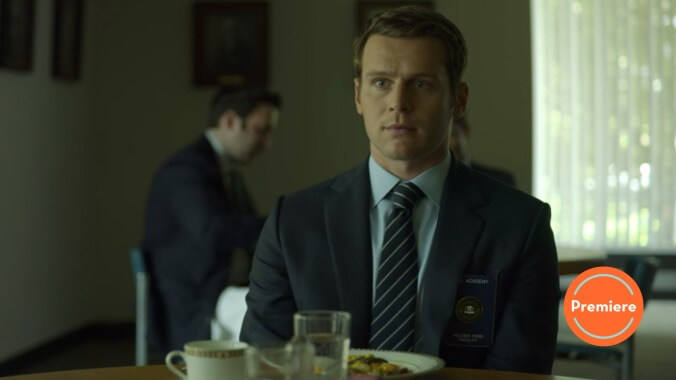Things are a little too good to be true on the Mindhunter season 2 premiere


Yes, David Fincher did return to direct the season two premiere of Netflix’s Mindhunter. But if you’re going in expecting a dramatic set piece like the hostage negotiation that opens up the series, let us be the first to disabuse you of that notion. It may seem strange to say as much about a season that opens with an interrupted act of autoerotic asphyxiation, but honestly not that much happens in the first episode. Status quos are restored, new characters are introduced, promises are made. The season is set up, in short. But if we’re going to be honest with each other for a moment, the most we get of the good shit, that detailed know-it-all shit that makes Mindhunter so enjoyable, is a cork board in the background of one scene.
That’s not to say this could have been directed by anyone; it’s a thoughtfully composed, immaculately color-coded episode of television that makes compelling use of light and shadow. The dominant palette is washed-out yellows and pale blues—the colors of the FBI logo—rendered especially sickly by the florescent lighting in “the basement” where Holden Ford (Jonathan Groff), Bill Tench (Holt McCallany), and Dr. Wendy Carr (Anna Torv) work. (Not that the light is especially vivid in Bill’s backyard, either.) Oh, and let’s not forget Gregg Smith (Joe Tuttle), the Jerry of this humorless little gang of morbid workaholics, who’s now been exposed as the mole who sent the tape of Holden’s—let’s say–ethically ambiguous interrogation methods to the OPI.
That tape was one of a few things that put the FBI’s fledgling Behavioral Science Unit on the radar of the bureau’s upper management, and in an unlikely twist, this actually seems to be a good thing. Old boss Shepard (Cotter Smith) is on his way out, and the new boss taking his place, Ted Gunn (Michael Cerveris), comes to Quantico with a vision that revolves around the BSU, and around Holden Ford in particular. Although he’s not on screen for a lot of it, Holden is the main topic of conversation this episode: Gunn pulls both Tench and Carr aside and asks them to keep an eye on the FBI’s most special boy, who appears to be evolving into the Will Graham-type savant we so often (too often, if you ask me) see on serial-killer dramas.
He’s also been diagnosed with panic disorder after receiving the Hug of Death from Ed Kemper (Cameron Britton) in the season one finale, a conclusion that provides some dramatic possibilities as well as furthering the “tortured enigma” nature of Ford’s character. Much like the serial killer, psychologists were still developing the concepts of panic disorders and panic attacks in the late ‘70s; the former wasn’t officially established as its own condition in the DSM-III until 1980. So Tench’s gruff misunderstanding of Ford’s problems tracks, as does Carr’s hesitancy discussing what little she knows about panic attacks with Ford, who’s been known to dive into the depths of human psychology without his water wings in the past.
It all points to things going a little too smoothly at the start. Gunn is obviously telling the BSU agents what they want to hear, appealing to Tench and Carr’s respective self-images as the adult in the room by asking them to watch over Ford and dangling the prospect of interviewing Charles Manson in front of Ford like a chew toy in front of a puppy. The OPI case investigating the unit’s practices also seems to have been resolved a little too easily, and it’s quite the happy coincidence that the lonely Carr seems to have stumbled upon a love interest in the bar Ford takes her to to talk about his diagnosis. Maybe everything really is coming up Mindhunter. But in the dark and cruel world these characters live in, it all seems awfully convenient. We’ll find out over the next few days whether that’s good writing, and we’re being set up for some complicated fallout, or bad writing where everything is just as it seems. There are a few clues—some subtle, as laid out in Stray Observations, and some more obvious, like that final scene—that lead me to believe it’s the former. But again, we shall see.
Stray Observations
- Now, to the cork board. There are a few famous names—John Wayne Gacy; Kenneth Bianchi, a.k.a. The Hillside Strangler; Ronald DeFeo Jr., whose murder of his family formed the real-life basis for the mostly made-up Amityville Horror—on it. But most are lesser-known, like George Howard Putt (upper right) and Douglas Gretzler (bottom left). There’s some interesting Googling to be had here, obviously.
- That’s Tench’s new case, the BTK killer, being caught in the lingerie-clad masturbatory act by his wife in the cold open, in case you didn’t put that together.
- In the process of writing this recap, I discovered that Project Runway’s Tim Gunn’s father was an FBI agent, and Gunn’s pretty sure he met J. Edgar Hoover in drag once. Tim Gunn’s father’s name was George William Gunn, so it’s not the same person Cerveris is playing on the show. (At least not literally.) But that was too good of a tidbit not to pass along.
- Shepard does say that Gunn worked “The SLA,” a.k.a. the Patty Hearst case, and “the Black Panthers”—which, if you know anything about COINTELPRO, means that Gunn is willing to do anything, even murder people, in service of the FBI.
- To quote the Doobie Brothers song that plays on the jukebox in the bar, “what a fool believes, he sees/ no wise man has the power to reason away/ what seems to be/ is always better than nothing/ than nothing at all.”